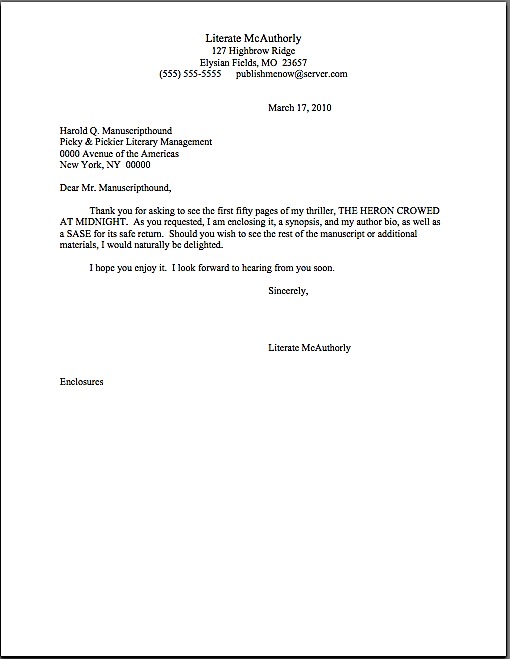





Okay, so I didn’t actually set out to bring a skeletons’ disco extravaganza to you today, even if it is St. Patrick’s Day. You’d be surprised at what comes up in a web search of skinny; it was either this or models, interestingly enough. (All of these fabulous animated bones appear courtesy of Feebleminds, by the way.)
No, I have a much nobler goal for today: answering a good question from a reader. Quoth the intrepid Kim a few posts back:
An agent recently requested a partial of ms. and not being able to find much on how to format that I just included the title page, and the requested pages of the ms. Is there a correct format or protocol for partials?
I’m very glad you brought this up, Kim. Although a partial always refers to a manuscript by definition — the term is shorthand for partial manuscript — this is yet another one of those situations where aspiring writers often get confused by publishing industry terminology.
Yes, I said yet another, because as so often seems to happen in the rumor echo chamber in which those trying to break into the biz must operate, many are the terms that mean more than one thing, or which would mean one thing to an agent and another to, say, a submitting writer. Here we have a prime example of the former: a partial can refer to two different kinds of manuscript, depending upon the context.
So let’s start this discussion by defining our terms before we really give the skeletons something to cavort about, shall we?
The two distinctly different flavors of partial: the first pages
The first kind of partial, the kind to which Kim refers here, is the a specified number of pages an agent may request from a successfully querying or pitching writer who is not yet a client. Emphasis on specified: no agent is simply going to tell an aspiring writer, “Send me a partial,” leaving the writer to guess how many pages and from what part of the book.
Instead, she will typically say, “Send me the first chapter/first 50 pages/first three chapters/first 100 pages.” In this context, then, a partial is precisely the number of pages an agent has requested to see.
Again, emphasis on precisely: if an agent asks to see the first 50 pages, don’t make the mistake of sending 52, even if page 50 ends in mid-sentence or the chapter ends on page 56. From an agent’s point of view, an ability to follow directions well is a very, very desirable trait in a potential client.
Basically, this type of partial is a writing sample, similar in function to the pages agents sometimes list in their submission requirements as addenda to the query packet or the 5-page writing sample agents sometimes ask pitchers to produce: the agent is asking for these pages primarily in order to see whether this aspiring writer can write; judging whether the book would be a good fit for the agency comes a close second, but if the agency’s screener (our old pal, Millicent, naturally) isn’t caught by the style, even a perfect plotline for that agent’s interests is likely to be rejected.
Oh, should I have warned you not to take that great big sip of coffee just before you read that rather disturbing paragraph? Go ahead and clean up; I don’t mind waiting.
I understand your shock at hearing it so bluntly put, oh spit-takers, but as we have discussed throughout our recent series on standard format, ruling out 90% of submissions as quickly as humanly possible is a big part of Millicent’s job. Her boss can only take on a handful of new clients in any given year, right? In order to save the agent time, she makes sure that the only requested materials to reach his desk are well-written, properly formatted, and the kind of story or argument the agent is actively looking to represent.
When an agency requests a partial rather than the entire manuscript, it’s essentially a means of streamlining this winnowing-down process even further. Not to mention saving her from having to shuffle, and thus lift, a ton of paper: instead of Millicent’s desk being piled up to her chin at any given moment with boxes of full manuscripts, the monthly influx of requested partials may reach only up to her sternum. Once she has screened those, her boss can decide which of the surviving partials have piqued their interest sufficiently to request the entire manuscript.
A process known, both colloquially and within the industry, as asking to see the entire manuscript.
So asking for a partial adds an intervening step between the initial query or pitch and the request for the full manuscript — but before those of you who would prefer your work to be judged in its entirety invest too much energy in glowering in Millicent and her boss’ general direction for sending writers jumping through this additional hoop, let me hasten to add that until fairly recently, most agencies almost always asked for a partial first; requesting the entire manuscript right off the bat used to be a sign that an agent was really, really excited about a book project and wanted to get the jump on any other agent who might have merely requested a partial.
Nowadays, the decision whether to request a partial or entire manuscript is less often an indicator of enthusiasm than a matter of agency policy. In fact, contrary to pervasive writerly opinion, being asked for a partial rather than a full can sometimes be an advantage: at some agencies, having the entire manuscript on hand earlier can enable even speedier rejection of a near-miss project. Think about it: instead of having to ask for pages 51-372 and wait for them to arrive in order to pass a final judgment on a book, Millicent can simply read to page 60.
If the verdict is yes, this can lop quite a bit of time off the agent-seeking process, from the writer’s perspective. Unfortunately, if the verdict is no, and the agency is one of the vast majority that utilize form-letter rejections, the submitter ends up with no idea whether the impetus to reject came on page 1 or page 371.
Renders it rather hard to improve the manuscript prior to the next submission, doesn’t it?
Before that rhetorical question depresses anybody too much, let’s return to defining our partials. 99% of the time, the kind of partial an aspiring writer will be asked to provide is this first kind: a requested number of pages, beginning on p. 1 of the manuscript, for submission to an agent. There is, however, another kind.
The two distinctly different flavors of partial: the taste of what is to come
After a novelist is already established, it is not unheard-of for her agent to be able to pull off a conjuring trick known as selling the next book on a partial. This is pretty much what it says on the box: the author produces the first X number of pages of a not-yet-completed novel, and the agent convinces an editor that it will be to the publishing house’s advantage to snap the book up before the author has polished it off.
This can be a good deal for the publisher: buying a book on a partial prevents other publishers from bidding on the finished work. Also, earlier involvement in the writing process often enables the editor to help shape the book more, in much the same way as an editor on a nonfiction book (typically sold on a book proposal, not the full manuscript, lest we forget) is able to dictate which of the proposed chapters will and will not be in the finished manuscript.
Not to mention the fact that if the book happens to be written by a famous author or celebrity in another field, the bidding could potentially get quite high. This is why, in case you’d been wondering, we all occasionally hear of a publisher’s acquiring a half-written novel at a cocktail party, because some celebrity simply handed ten pages to him along with his seventh martini: the publisher recognizes the potential marketing value of the name.
For your garden-variety serious novelist, however, such a situation is unlikely to arise. If her agent manages to sell her next book on a partial, it’s generally to the editor who acquired her last. Since so many first-book publishing contracts grant the publisher right of first refusal over the author’s next book, anyway — meaning that the publisher gets an exclusive peek at the book before anyone else can place a bid on it — selling on a partial is mostly a means to speed up the approval process.
Everyone clear on the difference between that kind of partial and the first kind? Excellent. Now let’s assume for a moment that, like Kim, you have just been asked to submit a partial to the agent of your dreams. What specifically are you being asked to do?
Let’s further assume that your manuscript (or whatever portion of it an agent or editor has requested that you send to be perused by Millicent, the Platonic agency screener) is already in tip-top formatting shape, all typos and logic problems removed, and thus what the industry calls clean — and if you’re not absolutely positive that your pages meet ALL of those conditions, stop right here and make a plan for tidying up your pages.
Trust me, this is a situation where spelling counts. As does grammar, punctuation, and everything else your 9th grade English teacher begged you to take seriously.
But once your work is in apple-pie order, as Louisa May Alcott used to say so frequently, what next?
What should a partial submission packet include, and in what order?
In part, this is a trick question, because — chant it with me now, readers — any submission packet should include precisely what the agent asked you to include, no more, no less. In the words of the immortal Fats Waller, find out what they like and how they like it, and let ‘em have it just that way.
Okay, so he wasn’t talking about literature when he sang that. Roll with me here.
As I mentioned above, agents are usually quite specific about what they want in a submission, up to and including how many pages they want to see. If you doubt this, check out an agency’s website or one of the standard agency guides, then attend a conference where agents are scheduled to speak. Raise your hand and ask whether it’s okay to send, say, the 55 pages it would take to round out a chapter when an agent has asked to see the first 50. You will be astonished at how people who say their preferences in clients are as vague as writers who produce “good writing in any genre” will suddenly transform into rule-hugging lovers of draconian efficiency, appalled at the very notion of extending the length of the partial.
To save you the trouble of asking, let me tell you what they will say: never, ever, EVER send what you THINK they want to see instead of what they have ASKED to see. Of course, you may offer in your cover letter to send more, but that is all.
So pull out your hymnals and sing along, campers: if you’ve been asked for the first 50, and the chapter ends in a blow-your-socks-off cliffhanger on p. 51, you should still only send the first 50, exclusive of the title page. (Since the title page is not numbered, it is not included in the page count, either.)
Of course, if you wanted to be Machiavellian about it, you could always perform a little strategic snipping prior to that, so said cliffhanger topples just on the bottom of p. 50. No one would fault you for that, for the very simple reason that it’s extremely unlikely that Millicent will ever sit down with your partial and full manuscript simultaneously. Partially, this is due to the fact that if an agency approves enough of a partial submission to want to see the rest of the novel, they’re going to ask for the entire manuscript, not, say, pages 51 through 373.
Oh, you thought Millicent was going to invest time in digging out your partial, unpacking your second submission, and fitting the two together like a jigsaw puzzle? Does that really sound like reasonable behavior to expect from the person too impatient to allow her latte to cool before taking her first sip?
Again, send precisely what you are asked to send. However — and this should sound familiar on the secret handshake front — any agent is going to assume that a writer of your caliber is already aware that certain requests imply certain inclusions. Here are the extra bits, in the order in which they are generally expected to appear in a packet containing a partial:
1. Cover letter
An astonishingly high percentage of submissions arrive without a cover letter, and often without a title page as well, begging the question: what makes these writers so positive that the requesting agent will still remember their queries or pitches well enough to render page one of chapter one instantly recognizable?
I hate to burst anyone’s bubble, but it’s not going to be — in fact, in many agencies, the person who heard the pitch or read the query won’t even be the first person to screen the submission. There may even be several Millicents who need to approve it before it gets anywhere near the agent of your dreams. So it doesn’t honestly make sense to assume that everyone who sets eyes on your manuscript will already be familiar with your work.
Besides, including a cover letter is polite. No need for a long-winded missive — a simple thank-you to the agent for having asked to see the materials enclosed will do. Something, perhaps, along the lines of this little gem:

A miracle of professional blandness, is it not? That’s all right — the cover letter isn’t where you’re going to wow Millicent with your sparkling prose and trenchant insight, anyway. All you have to be here is polite.
If you met the agent at a conference, mention that in the first paragraph of the letter, to help place your submission in context. (As crushing as it may be to the writerly ego to contemplate, an agent who spent days on end listening to hundreds of pitches probably is not going to remember each one. No need to re-pitch, but a gentle reminder never hurts.
If another agent is already reading all or part of the manuscript you’re sending — or has asked to see it — mention this in your cover letter. No need to say who it is or how long s/he has had it; just tell the recipient that s/he’s not the only one considering representing this book. Unless the agency has a policy forbidding simultaneous submissions, withholding this information will only generate resentment down the line if more than one agent wants to represent your book.
Yes, even if that agent to whom you submitted 9 months ago has just never responded. Actually, it’s in your strategic interest to contact that non-responder to let her know that another agent is interested; it often speeds up the evaluation process. (If you’re unclear on why, please see the WHAT IF MORE THAN ONE AGENT ASKS TO SEE MY MANUSCRIPT? category on the archive list at right.)
Most importantly, make sure all of your contact information is on the letter, either in the header (letterhead-style, as in the example above) or just under your signature, and do be absolutely certain that the letter includes the title of your book, just in case the letter and the manuscript end up on different desks.
Yes, it does happen. You want them to be able to get ahold of you to tell you how much they love your writing, don’t you?
2. Title page
Always include this, if any manuscript pages have been requested — yes, even if you have already sent the first 50 pages, and are now sending the rest of the book.
No need to state on the title page that it’s a partial, either — Millicent will be able to figure that out from your cover letter and the thickness of the stack of paper. Just use the same title page that you would have used if the agent of your dreams had requested the entire manuscript, and you’ll be fine:

Again, not precisely a thrill-fest, but undoubtedly professional-looking. Just make sure that it’s in the same typeface as the rest of the attached manuscript. (If this all sounds completely cryptic to you, or if you have never formatted a professional manuscript before, don’t panic — you’ll find a step-by-step explanation of what to do under the HOW TO FORMAT A TITLE PAGE category at right.)
Why is it so very important to include the title page? Long-time readers, chant it with me now: because the submission looks more professional that way. Also, like the cover letter, the title page renders it easy for an agent to track you down. Believe me, if the agent of your dreams falls in love with your manuscript, you’re going to want to hear about it right away.
3. The requested pages in standard format.
Again: only the pages they’ve asked to see, beginning on page 1, professionally formatted. No substitutions, unless the agency website specifically asks for something else. (If you’re new to reading this blog, or have somehow avoided the last few weeks of repeated and vehement posts on standard format, please see the HOW TO FORMAT A MANUSCRIPT and STANDARD FORMAT ILLUSTRATED categories on the list at right._
For the benefit of those of you who are going to blow off that last piece of advice because you’re in a hurry — oh, I know that you’re out there — allow me to add something you would have learned from those posts on formatting, had you been paying attention: a manuscript intended for submission should not be bound in any way.
Oh, and do use at least 20-lb, bright white paper when you print it out. Cheaper paper can begin to wilt after the first screener has riffled through it. Yes, it does increase the already quite substantial cost of submission, but this is one situation where being penny-wise can cost you serious presentation points.
“So basically what you’re saying, in your patented lengthy and meticulously-explained manner,” those of you who have been paying close attention point out, and rightly, “is that Kim did everything right. Aren’t you?”
Why, yes, I am — kudos for your submitting savvy, Kim! You’re an example to aspiring writers everywhere, all the more so, in my opinion, because you were brave enough to ask the question. Now, everyone who has been wondering about it can benefit.
Sometimes, though, agents ask to see additional materials slipped into a submission packet with a partial. Next time, we’ll be taking a swift barefoot run through the usual suspects, as well as revisiting the difference between a partial and a writing sample — or a partial for a contest entry and a writing sample, for that matter.
Hard to contain the excitement, isn’t it? No wonder the skeletons are dancing up a storm. Happy St. Patrick’s Day, everyone, and keep up the good work!
Oh thank goodness I did it right! Mostly because I assumed what to do from the information on this blog, which if I get published, will definitely be in the acknowledgments. 😀
Thank you so much for taking the time to answer my question!
You’re entirely welcome, Kim — but had I not already mentioned that from what you had described, you had done it perfectly? I didn’t mean to leave you in suspense!
*Head-desk* again. I did it wrong. All via email and I never in a million years thought of a title page. My cover letter was a response to the one liner asking for the chapters. . .along the lines of thank you, please find attached, and looking forward to hearing from you, thanks for the consideration. And my email attachment was exactly the chapters for which the agent asked.
So do I resend (after having committed three faux pas? Missing title page, brief bordering on non-existent response email, and using the same subject header QUERY instead of REQUESTED MATERIALS)? Or just slink off into the corner and wait for the ‘no response’ to my bumblingness.
No need to slink, G — but I definitely wouldn’t advise re-sending it IF you just hit REPLY, so that the subject line read RE: QUERY. That would tell the agent that it was a response. It’s a small, common faux pas, unlikely to trigger rejection. The same applies to the title page, and your cover e-mail sounds minimal, but fine.
If QUERY was the totality of the subject line, though, it’s more of a quandary. Millicent probably figured out from your thanks that this was a submission, not a query, but the chances of being mistaken for an unsolicited submission are quite a bit higher. Again, though, I would wait for at least a month before resending it — and in this case, I would advise sending it with a brief apology in the cover letter, saying that you realized that you had mislabeled your submission in a way that might have rendered it harder for the agency to process. It’s not necessary, strictly speaking, but agents do tend to appreciate good manners.